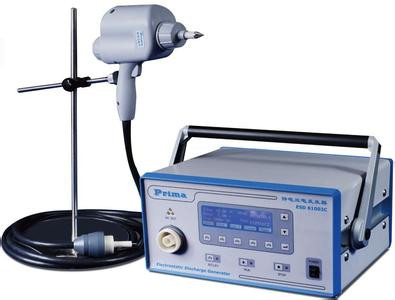The principle and correct use of electrostatic tester

The electrostatic tester is a non-contact portable electrostatic field tester. The instrument host consists of a corona discharge device, a probe and a detection system.
There are contact and non-contact electrostatic field testers. The measurable range is+/-200KV. The shell is made of anti-static material and has Ground buckle to ensure reliable measurement results.
Principle
Use the given A high-voltage electric field is used to regularly discharge the test sample, causing the sample to induce static electricity, thereby detecting the amount of electrostatic charge, the half-life of electrostatic voltage, and the residual amount of static electricity to determine the electrostatic properties of the test sample.
Purpose
Mainly used for testing fabric raw materials and finished products (including fibers, yarns, fabrics, carpets, decorative fabrics) under laboratory conditions ) can also be used to measure the electrostatic properties of other sheet and plate materials such as paper, rubber, plastic, laminate sheets, etc.
1: The formation of resin products, film sorting, etc.
2: Integrated circuit board printing.
3:ESDProtection.
4:Complete machine, pay attention to dust removal and static removal of parts.
How to use
Single press to reset
Single click to show lock
Automatic shutdown when idle
Battery performance display
Function: Effectively detect electrostatic charges on ESD workplace equipment, work surfaces, and tools.
Features: LCD/level display detection data, test data retention, digital clear display, high/low range.
Output: Red LCD displays positive charge, blue LCD displays negative charge
Accuracy: Low range accuracy is: plus or minus 0.1kv
High range accuracy: plus or minus 1kv
Input voltage: 9V, 6F22
Nickel battery
Electrostatic field can be measured: +/- (0.00-20.0kV) (automatic display adjustment)
Standard ranging: 25mm+/-1mm
Ion balance can be measured: +/-(0-200V)
Measuring distance according to: ESD-STM3.1-2000
Ion balance standard
LCD display update: 5 times per second
Response time: 1 second
Working temperature and humidity: 10-40
deg C/RH:0-60%R
Graphic display: positive: red/
Negative: Blue
Audio alarm: power on/automatically shut down when idle/out of measurable range
Automatic shutdown: idle for about 5 minutes
Measurement mode switching
Electrostatic field: Single press the Power button, there will be a beep
Ion balance (please install the ion balance measurement board first) press Zero and Power at the same time, there will be two beeps
Notes
1.Before measuring, you should first check whether the power supply complies with the regulations and whether the instrument Check whether the shell (including the outer shielding tube of the probe) is well grounded and the instrument can be tested only after it is cleared.
2. The test probe should be kept at a certain spatial position perpendicular to the surface of the charged object being measured (according to the test distance specified in the instrument instructions). Changes in the test distance will lead to large test errors. . In order to avoid spark discharge between the charged object being measured and the probe shell, when starting the measurement, the probe must be placed far away (away from the charged object) and gradually approach the charged object.
3. Test surface potential���, generally the surface of the charged body should be far enough away from the grounding body. If the charged body is in the form of a sheet or film, and the back is close to the grounding body, when the probe moves near the grounding body, there is a risk of space discharge or surface discharge due to the concentration of local charge induction.
4. When the measured part of the charged body is a larger flat plate, the measured value is more accurate, but when the measured surface of the charged body has a certain radius of curvature, the measured value is equal to The actual potential value is quite different.
5. The impact of the instrument’s own characteristics on the test accuracy should be considered, and regular calibration and calibration should be performed before use.
6. The shielding depth of the probe has a certain impact on the test accuracy. The inductive electrostatic field tester essentially tests a certain local electric field of the charged body under test, so it must completely reduce the external electric field. The interference and influence of electric field on test signals. The usual method is to install this type of instrument and its probe in a grounded shielded shell. Obviously, if the outer shielding sleeve of the probe is too deep, it will reduce the test accuracy of the instrument, and if it is too shallow, it will easily be affected by external electric fields.
7. The value obtained by testing the surface potential of an object can be used as a qualitative reference. Accurate measurement is difficult to achieve in actual work due to various factors.
8. Generally, the electrostatic voltmeter used in the electronics industry must consider the testing accuracy and should be able to test the electrostatic voltage of ±10v.
AAA57865ERT34GSD
Disclaimer:
Disclaimer: Some of the texts, pictures, audios, and videos of some articles published on this site are from the Internet and do not represent the views of this site. The copyrights belong to the original authors. If you find that the information reproduced on this website infringes upon your rights, please contact us and we will change or delete it as soon as possible.
AA







